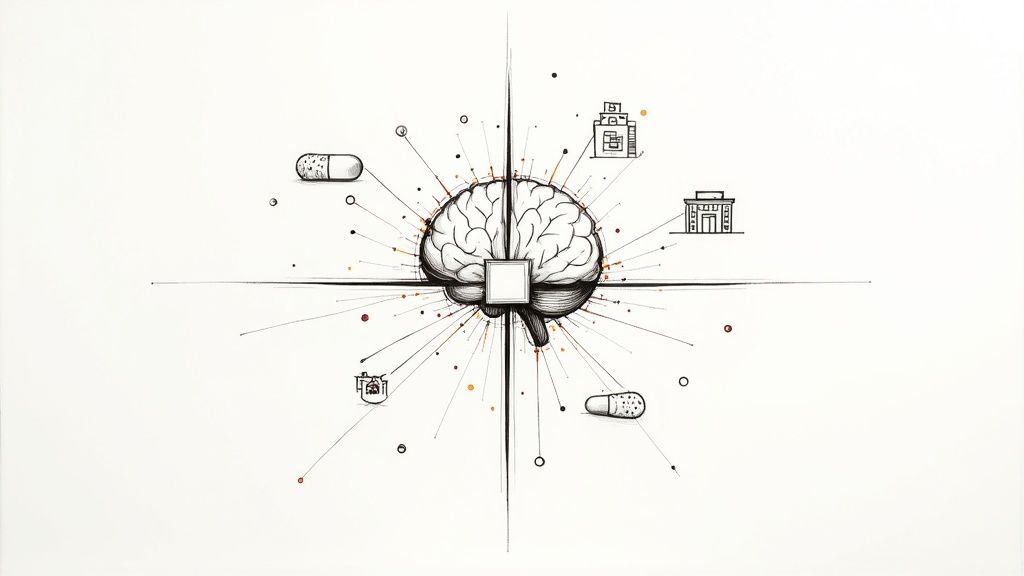Mastering AI Adoption Frameworks for Business Growth
Discover proven AI adoption frameworks to guide your business transformation. Learn to build a clear strategy, overcome challenges, and drive measurable growth.
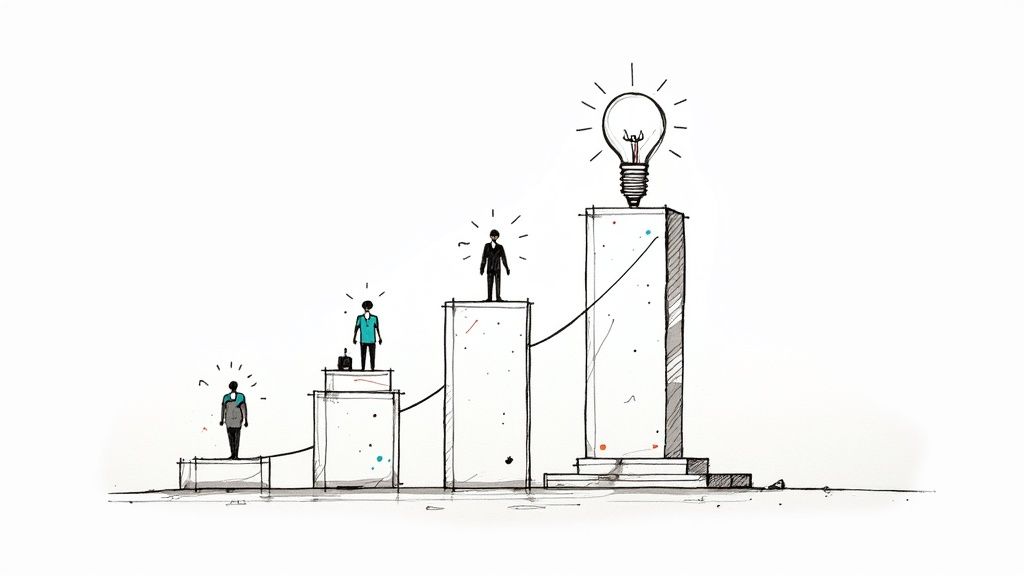
Everyone's talking about 'AI adoption', but what really separates a successful initiative from a costly experiment? The answer is an AI adoption framework. This is your strategic blueprint, the master plan that guides your organisation from scattered, disconnected AI projects to a unified, powerful strategy.
Think of it like building a skyscraper. You wouldn't just start stacking bricks and hope for the best, would you? You'd need detailed architectural plans. An AI framework serves that exact purpose.
Why Your Business Needs a Strategic Framework for AI

Diving into artificial intelligence without a solid plan is like trying to navigate a maze blindfolded. Many organisations are eager to get started, but they often fall into the trap of launching isolated, ad-hoc AI projects. This scattergun approach almost always leads to wasted resources, duplicated efforts, and initiatives that fizzle out before delivering any real value.
A formal AI strategy framework provides the essential structure to sidestep these common pitfalls. It fundamentally changes the internal conversation from "What cool AI tool can we use?" to "How can AI solve our most pressing business problems?" That shift in perspective is absolutely crucial for any kind of long-term success.
From Unstructured Efforts to Unified Strategy
Without a framework, it's a free-for-all. Different departments might chase their own AI ventures, creating a fragmented and inefficient mess. This lack of coordination inevitably leads to data silos, incompatible technologies, and a poor return on your investment. The whole point of an effective framework is to align every single AI effort with your core business objectives.
A structured framework isn't about stifling innovation; it's about channelling it effectively. It ensures that every investment in AI is deliberate, measurable, and contributes to a larger strategic vision.
This organised approach is especially important when you look at how unevenly AI is being integrated across different markets. Take Germany, for instance. Despite all the global buzz, AI adoption there has seen only marginal growth. A 2023 study found that 12% of German companies were using AI, just a slight increase from 11% in 2021. While this is a touch higher than the EU average of 8%, it really shines a light on the challenges that a formal framework can help a business overcome. You can discover more findings on German AI adoption from the ZEW study.
Key Benefits of a Formal Framework
Putting a proper AI adoption framework in place brings several immediate advantages that help your organisation move beyond just experimenting and towards sustainable growth.
Here are a few of the big ones:
Minimised Risk: It gives you a structured way to assess and manage risks around data privacy, security, and ethical issues before they blow up into major problems.
Resource Optimisation: A unified plan stops different teams from spending money on the same software or infrastructure, making sure your resources are channelled into the most impactful projects.
Clear Governance: The framework establishes who owns what and who is accountable. This is vital for managing complex AI systems and ensuring they're used responsibly across the entire organisation.
By creating a clear path forward, a framework turns AI from a buzzword into a genuine competitive advantage. As we explored in our AI adoption guide, this strategic alignment is the bedrock of success. The right AI strategy consulting can be invaluable in helping you build this foundation.
What Holds Up a Successful AI Initiative? The 5 Key Pillars
Think of a strong AI adoption framework not as a static document, but as a living, breathing system. It's supported by several crucial pillars, much like the foundation of a building. If any one of these pillars is weak or neglected, the whole structure becomes unstable, putting your entire AI ambition at risk.
These pillars aren't just abstract concepts; they form a practical blueprint that connects your high-level goals to what your teams are doing on the ground every single day. Let's walk through what they are.
1. Strategy and Vision
This is your starting point, the absolute foundation. Before you even think about tools or data, you have to answer one fundamental question with total clarity: "What, exactly, do we want AI to do for our business?" This isn't a tech question; it's a business question.
A solid strategy means setting specific, measurable goals. Are you trying to boost operational efficiency by 15%? Or maybe you're focused on cutting customer churn or even inventing entirely new revenue streams. Whatever the objective, it must link directly to your company's core mission. You'll also need full backing from leadership to get the budget and resources required.
2. Data and Infrastructure
Data is the fuel for any AI engine. It's simple: your AI models will only ever be as good as the data you feed them. This makes your data strategy absolutely non-negotiable. You need a clear plan for how you'll find, clean, store, and access the information your AI will use.
A few things to nail down here:
Data Quality: You have to ensure your data is accurate, complete, and doesn't contain hidden biases. Biased data leads to skewed, unfair, or just plain wrong outcomes.
Data Accessibility: Most organisations have data stuck in different departmental silos. You need to break those down to create a unified source of truth that your AI systems can actually use.
Infrastructure Readiness: Can your current IT setup handle the heavy lifting AI requires? Be honest about whether you need to invest in cloud computing, new hardware, or other upgrades.
3. People and Culture
Throwing technology at a problem rarely solves it. You need the right people with the right skills, working within a culture that is open to change and isn't afraid to experiment. This pillar is all about the human side of the equation.
It's a two-pronged approach. First, upskill your existing teams—they have priceless knowledge about your business. Second, bring in new talent with specialised AI skills where you have gaps. Creating an environment where different departments work together and people feel safe to "fail fast and learn faster" is key to keeping things moving.
4. Technology and Tools
Once you have a clear strategy and a team ready to execute, then you can start looking at the tech. This pillar is about navigating the crowded marketplace of AI platforms, models, and vendors to pick what's right for you. A good AI strategy framework prevents you from just chasing the latest shiny object and helps you focus on what will actually deliver value.
A common mistake is chasing the most powerful tool on the market. The real goal is to find the tool that best solves your specific business problem.
5. Governance and Ethics
Finally, you need guardrails. The governance and ethics pillar provides the essential rules of the road for your entire AI programme. As AI becomes more deeply woven into your operations, using it responsibly isn't just a good idea—it's a necessity. This means creating clear policies around data privacy, security, and making sure your algorithms are transparent.
This pillar tackles the tough questions: How do we make sure our AI models are fair? How are we protecting sensitive customer information? Who is ultimately accountable if an AI system gets something wrong? Building trust with your customers, partners, and regulators starts with being proactive and transparent about how you govern your AI.
Your Step-by-Step AI Implementation Journey
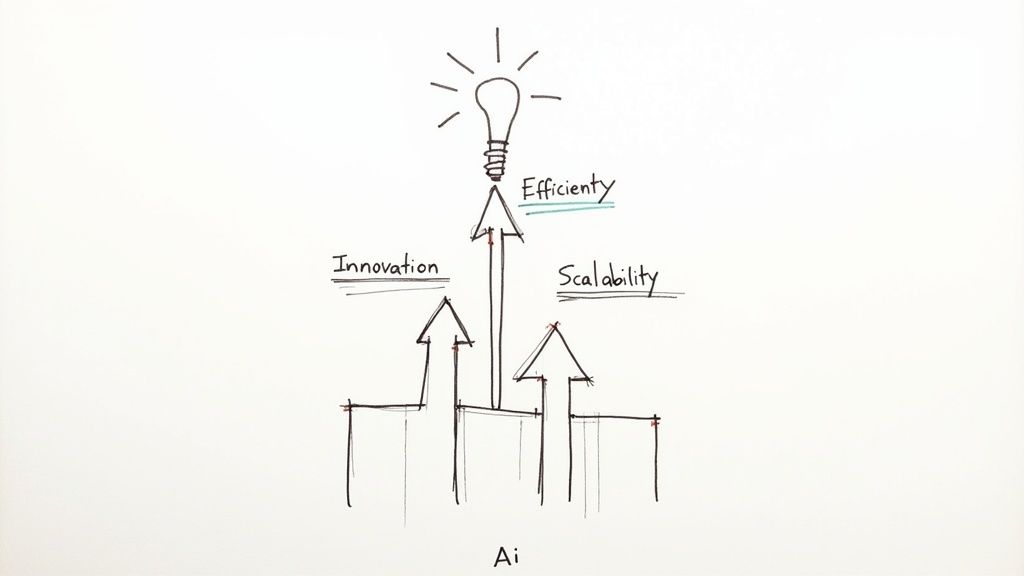
Moving from a high-level AI strategy to a real, working solution in your business isn't magic. It requires a clear, methodical roadmap. Think of an AI adoption framework as your guide for this journey, breaking down a massive undertaking into a structured, step-by-step process from the first idea to a fully operational system.
Tackling the AI implementation in distinct phases is the smartest way to build momentum, handle risks, and make sure you're getting the most out of your investment. It turns what could be an overwhelming project into a series of manageable, logical steps. This approach, often guided by expert AI strategy consulting, is what keeps everything on track and focused on delivering genuine business value.
Let's walk through the four critical phases of bringing AI to life in your organisation.
Phase 1: Assessment and Readiness
Before you start building, you need to survey the land. This first phase is all about taking a good, hard look at your organisation's current state. It’s less about the shiny new tech and more about an honest evaluation of your operational, cultural, and strategic readiness for AI.
You have to take stock of what you've already got. How clean is your data? What skills do your teams possess? Which business processes are crying out for the kind of automation or insight AI can provide? This is where you find those high-impact, low-complexity "quick wins" that make for a perfect starting point.
Key activities here usually involve:
A Capability Audit: Getting a realistic picture of your data quality, tech infrastructure, and internal talent.
Identifying Opportunities: Pinpointing specific business problems or goals where AI could make a real difference.
Aligning Stakeholders: Making sure leadership and key teams are all on the same page, sharing the vision and understanding the initial goals.
Phase 2: Pilot and Proof of Concept
Once you have a clear picture of your readiness, it's time to start small and prove that your idea works. A pilot project is essentially a controlled experiment, designed to test your assumptions on a limited scale. The goal isn’t to change the whole company overnight; it’s to get a quick, measurable win on the board.
This is where a detailed AI requirements analysis is worth its weight in gold. It helps you focus the pilot on solving one specific problem with crystal-clear metrics for success. A successful pilot builds incredible momentum, gets people excited, and gives you the hard data you need to justify more investment.
A well-executed pilot project acts as your most powerful internal marketing tool. It transforms AI from a theoretical concept into a demonstrated success story, making it far easier to get buy-in for broader initiatives.
Ultimately, this phase is all about learning and validation. You’ll discover what works in your unique environment, run into unexpected challenges, and get to refine your approach before you commit to a much larger rollout.
Phase 3: Scaling and Integration
After your pilot has proven its value, the next logical step is to expand on that success. Scaling means taking the lessons from your initial project and applying them more broadly across the business. This could mean rolling out the solution to other departments, weaving it into more business processes, or using it to tackle bigger, more complex problems.
This phase demands careful planning to ensure the new technology slots neatly into your existing systems and workflows. It’s about making AI part of the very fabric of your core operations, so it feels like a natural part of how you do business. Moving from a standalone project to a deeply integrated system is the critical jump needed to achieve widespread impact.
Phase 4: Optimisation and Governance
Getting AI up and running isn't a one-and-done deal; it's a continuous cycle of improvement. This final phase is all about ongoing monitoring, fine-tuning, and governance. You need to constantly track how your AI systems are performing to ensure they’re delivering the results you expect and adapting as the business changes.
This involves setting up clear rules to manage your models, uphold ethical standards, and ensure they remain reliable over the long term. As we’ve covered in our AI adoption guide, strong governance is the bedrock of trustworthy AI. This ongoing optimisation, often guided by an expert team, ensures your AI initiatives stay effective, compliant, and perfectly aligned with your strategic goals for years to come.
Comparing Leading AI Adoption Frameworks
With so many models out there, figuring out which AI adoption path is right for your business can feel like trying to find a needle in a haystack. We'll look at some of the most common frameworks from big names like McKinsey, Deloitte, MIT, Google, and Microsoft. Each one comes with its own philosophy and method, designed for different kinds of organisations.
Some frameworks are clearly built for large, established companies that already have sophisticated data systems in place. Others are geared towards agile startups that need to innovate and test ideas quickly. As we touched on in our AI adoption guide, getting a feel for these differences is the first step to picking a model that actually fits your company's culture, goals, and day-to-day reality.
Core Philosophies and Strengths
Most of the top frameworks cover similar ground, but they each place their emphasis differently. For instance, a model from a major consulting firm like McKinsey or Deloitte will almost always prioritise a top-down, strategic approach. Their goal is to make sure every single AI project is directly linked to financial results and clear business value. Their main strength is in governance and managing transformation on a massive scale.
On the other hand, frameworks from tech giants like Google or Microsoft are usually more focused on the technology itself. They map out the practical stages of development, from getting data ready and building models to deployment and making improvements over time. They shine by giving technical teams a clear, step-by-step path to follow, often backed by their own powerful suites of tools. Then you have academic frameworks, like those from MIT, which try to strike a balance between the two. They often focus on fostering a culture of experimentation that's supported by strong ethical principles and strategic oversight.
This is a great way to visualise the typical trade-offs between time, risk, and return on investment during the early stages of bringing AI into a business.
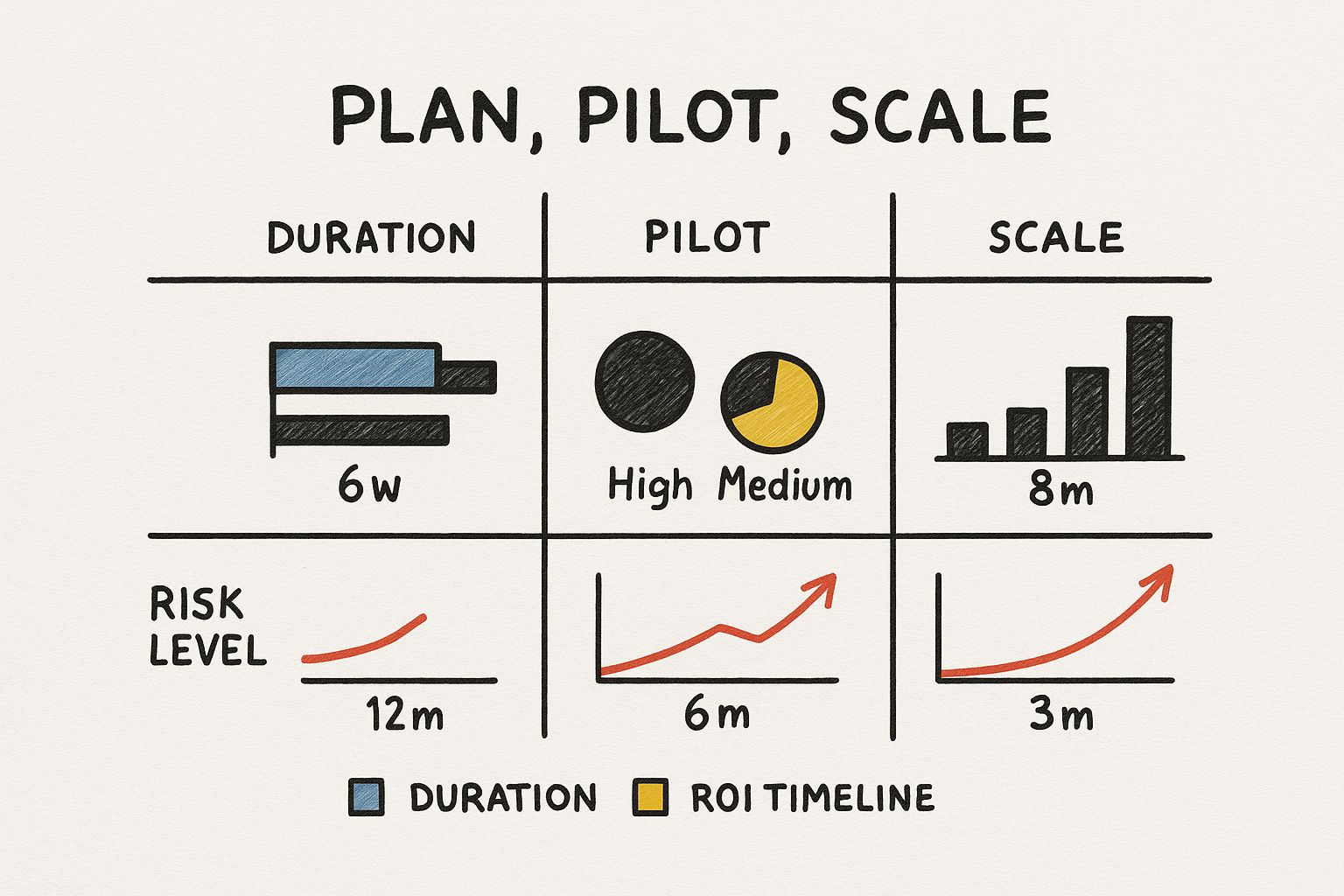
As you can see, the initial planning stage often involves more risk and takes longer, while the pilot and scaling phases that follow are designed to lower that risk and speed up the financial returns.
Comparison of Major AI Adoption Framework Models
To help clarify the differences, this table compares some of the leading AI adoption frameworks, highlighting what they focus on and where they work best.
Framework Source | Core Focus | Key Strength | Best Suited For |
|---|---|---|---|
Consulting Firms (e.g., McKinsey, Deloitte) | Strategic Alignment & Value Realisation | Top-down governance, ROI tracking, and large-scale change management. | Large enterprises aiming to tie AI initiatives directly to financial outcomes and C-suite objectives. |
Tech Giants (e.g., Google, Microsoft) | Technical Implementation & Scalability | Provides clear, tool-supported pathways for data, development, and deployment. | Organisations with technical teams ready to build and scale AI solutions using specific cloud platforms. |
Academic Institutions (e.g., MIT) | Responsible Innovation & Culture | Balances strategic goals with ethical considerations, focusing on building a sustainable AI culture. | Businesses wanting to build a long-term, responsible AI capability grounded in research and ethics. |
Each model offers a valuable perspective. The key is finding the one whose worldview aligns most closely with your own organisation's needs and current maturity level.
Matching a Framework to Your Organisation
Choosing the right framework isn’t about finding the “best” one overall—it’s about finding the best fit for your team. A collaborative approach, often called AI co creation, is the surest way to land on a model that genuinely works for your specific situation.
Think about these factors as you weigh your options:
Organisational Size and Maturity: A global corporation has completely different governance needs than a 50-person startup. Big companies often benefit from a comprehensive, governance-heavy framework, whereas smaller firms might do better with something more agile and iterative.
Industry and Regulatory Environment: If you’re in a highly regulated field like finance or healthcare, you have to put compliance, data security, and model transparency first. A framework with a heavy focus on risk management is non-negotiable.
Strategic Objectives: What’s the main goal here? Are you trying to streamline internal processes, launch new products for customers, or completely shake up your market? The framework you pick should be a direct support for these goals. For example, if innovation is the name of the game, seek out models that champion quick prototypes and learning from real-world use cases.
Technical Expertise: Your team's current skill set is a huge piece of the puzzle. If you have a deep bench of data scientists and machine learning engineers, a technically dense framework could be perfect. If not, a model that leans more on strategy and works alongside external experts might be a smarter choice. Our AI Strategy consulting tool can help you assess and close that gap.
A critical mistake is adopting a framework just because it’s popular. The most effective approach is to analyse your own organisation’s DNA—its culture, resources, and goals—and select a framework that amplifies your strengths and addresses your weaknesses.
At the end of the day, the best AI adoption frameworks aren't rigid rulebooks; they're flexible guides. They give you a structured way to think that you can adapt to your own unique circumstances. The right AI strategy consulting can help you not only choose a framework but also tailor it, making sure it truly fuels your AI ambitions instead of becoming another layer of red tape.
Overcoming Common AI Adoption Hurdles
Having a solid framework is a great start for any AI journey, but let's be realistic—even the best plans run into a bit of turbulence. Knowing what to expect and preparing for common obstacles is what makes the difference. Most of these challenges boil down to three things: finding people with the right skills, getting investment in a tight economy, and connecting exciting research to what actually works on the ground.
Tackling these head-on is what separates a stalled project from a successful one. For many companies, the best way forward is a smart mix of hiring for specific gaps and training the people you already have.
Bridging the Skills and Culture Gap
Finding enough people who really know AI is one of the biggest roadblocks. But you don't need a whole platoon of data scientists on day one. A much smarter move is to upskill your current team. These are the people who already know your business inside and out, and that knowledge is priceless. You can then bring in a few specialists to create a really powerful, well-rounded team.
Beyond the technical side, getting the culture right is absolutely crucial. A successful AI co creation process needs a culture that's open to trying new things, where failure is just seen as a chance to learn. A great way to get past that "we've always done it this way" attitude is to start small. Run a pilot project that solves a real problem and delivers obvious value. This helps sell the bigger idea of AI all by itself.
A critical first step in overcoming internal resistance is to demystify AI. Frame it not as a complex, intimidating technology, but as a practical tool that empowers employees to solve problems and work more efficiently.
Securing Investment and Proving Value
Getting money for an AI project, especially when budgets are tight, demands a rock-solid business case. It's not enough to talk about vague potential; you have to show a clear line to a return on investment (ROI). This means linking your AI plans directly to things the business cares about, like cutting costs, boosting revenue, or making operations run smoother.
This is a particularly big deal in the German market. The OECD's Artificial Intelligence Review of Germany points out that while the country is a leader in AI research, its businesses haven't kept pace. Key areas like manufacturing have been slow on the uptake, held back by industry-specific hurdles, a shortage of AI skills, and a generally cautious approach to investment.
Practical Strategies for Overcoming Hurdles
When you see these roadblocks coming, you can build a more resilient AI adoption plan. Here are a few practical ways to do just that:
Develop a Phased Training Programme: Don't just send everyone on a single course. Blend internal workshops with external training to create a culture where learning about AI is an ongoing thing. As we explored in our AI adoption workshop guide, a structured approach is key.
Build a Compelling Business Case: Kick things off with a small, focused pilot project. Make sure you know exactly what success looks like and how you'll measure it. The results from that pilot will give you the hard data you need to ask for more investment.
Engage External Expertise: Sometimes, bringing in experts is the fastest way to get moving. Specialised AI strategy consulting can give you the focused guidance to tackle everything from finding talent to building a business case that gets a "yes".
By thinking about these common hurdles from the start, you can make sure your AI adoption framework is more than just a document. It becomes a living guide that drives real, lasting success.
How Successful German Companies Apply AI Frameworks
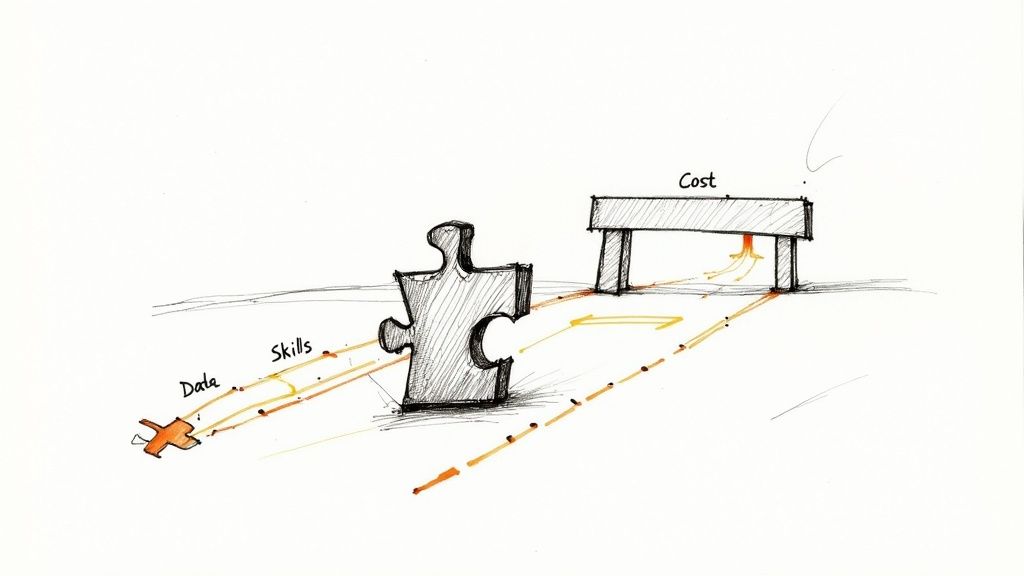
It’s one thing to talk about AI frameworks in theory, but it’s another to see them delivering real-world results. Germany, known for its industrial prowess and growing tech scene, offers some fantastic examples of how a structured approach to AI can build serious business value. These stories bring the core components of a framework—from high-level strategy to the nuts and bolts of deployment—to life.
Take the e-commerce sector. Otto, a household name in German online retail, has woven AI algorithms deep into its customer experience. By analysing browsing habits and purchase histories, their systems get remarkably good at predicting what a customer might want to see next. This makes shopping feel more intuitive and personal.
But the real magic is the impact on the bottom line. The same AI that personalises the storefront also calculates the probability of a product being sent back. By flagging orders with a high return risk, Otto can step in before the item even ships, a move that has massively cut down on expensive returns. This is one of the clearest real-world use cases of AI delivering a direct financial win. It’s part of a bigger picture, too, with the German government championing AI across its key economic centres. You can read more about Germany's strategic AI initiatives to see the market-level impact.
From Retail to Manufacturing
Of course, you can't talk about German industry without mentioning its legendary manufacturing sector. Here, AI frameworks are also making a huge difference. Automotive and industrial giants are well past the pilot phase, now using AI for predictive maintenance. Instead of reacting to a breakdown, their systems analyse data from sensors to see failures coming.
This kind of foresight is a game-changer. It leads to:
Less Downtime: Repairs can be scheduled during planned breaks, sidestepping the massive disruption and costs of an unexpected production halt.
Greater Efficiency: Optimising maintenance schedules and spare parts inventory means less waste and a much smoother operation overall.
Improved Safety: Spotting potential equipment failures early on is crucial for preventing accidents and keeping the shop floor safe.
These success stories, whether from a retailer or a factory, all started in the same place: not with the technology, but with a clear business problem. The AI framework gave them the roadmap to pinpoint the right challenge, dedicate the right resources, and build a solution that actually worked.
For any business, these examples provide a valuable blueprint. The journey always begins with a solid AI strategy framework that connects your business goals to the right tools and workflows. Whether you're trying to fine-tune a factory line or perfect a customer's online journey, a methodical approach is what turns an AI idea into a tangible success. By learning from how others have done it, you can gather practical insights for your own plans and build a strong foundation with guidance from our expert team.
Ready to Make Your Move?
Starting your AI journey is a big step, but it’s not one you have to take on your own. We've walked through why having a solid plan is so crucial, but theory only gets you so far. Now, it's about putting that knowledge into practice.
If you want to make sure you have the right expertise in your corner, why not have a chat with our expert team? Our specialists live and breathe this stuff, and they can give you the hands-on guidance needed to build an AI adoption framework that actually works for you. We're here to help you get on the fast track to real, sustainable growth powered by AI, making sure it all fits with your unique goals and how your business actually runs.
Frequently Asked Questions About AI Adoption Frameworks
Let’s tackle some of the common questions that pop up when people start thinking about AI adoption frameworks. Getting these cleared up can help you sidestep potential roadblocks and build momentum for your own strategy.
What Is the First Step in Building an AI Framework?
The very first move, before you even whisper the word "technology," is to nail down a crystal-clear business strategy. You need to know exactly what you're trying to achieve with AI and ensure it lines up perfectly with your company's bigger picture.
Just as important is getting your leadership team on board right from the start. Their buy-in isn't just a formality; it's what secures the resources, authority, and organisational energy needed to see the initiative through.
How Does a Framework Differ From a Single AI Project?
Think of it this way: an AI project is a one-off, tactical mission designed to solve a single, specific problem. An AI adoption framework, on the other hand, is the strategic blueprint for your entire organisation. It's the master plan that guides all your AI efforts.
A solid framework makes sure every project works together, contributes to the main business objectives, and has the right data, people, and ethical guardrails in place. It stops you from ending up with a bunch of disconnected, siloed projects that don't add up to much.
An AI framework transforms your efforts from a collection of standalone experiments into a coordinated, strategic programme. It’s the difference between building a single brick wall and constructing an entire, well-designed building.
Do I Need to Hire More Data Scientists to Use a Framework?
Not always. One of the most important pillars of a good framework is talent development, which often means upskilling the people you already have. Many businesses discover their secret weapon is training existing employees who already have that irreplaceable, deep-seated knowledge of the business.
This approach creates a powerful combination of internal business savvy and fresh AI skills. Ultimately, the right path depends entirely on your company's specific situation and what you're aiming for long-term. For more detailed answers, feel free to explore our full FAQ page.
Ready to turn strategy into action? Ekipa AI provides the tools and expertise to build and implement a custom AI framework that drives real business results. Connect with our expert team to accelerate your AI journey today.



